
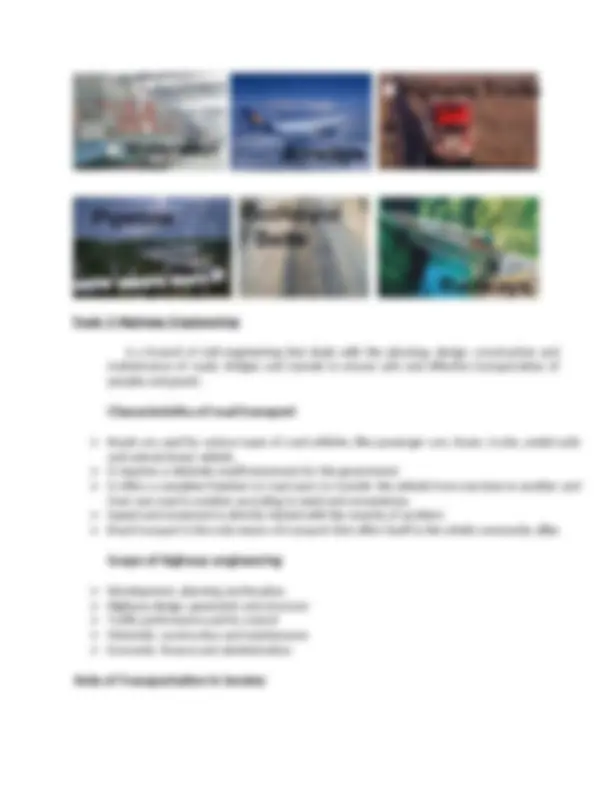
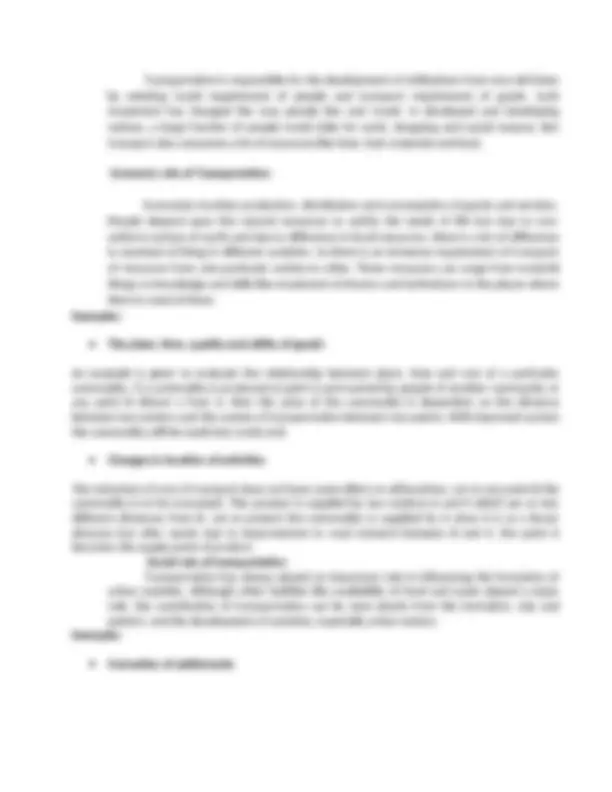
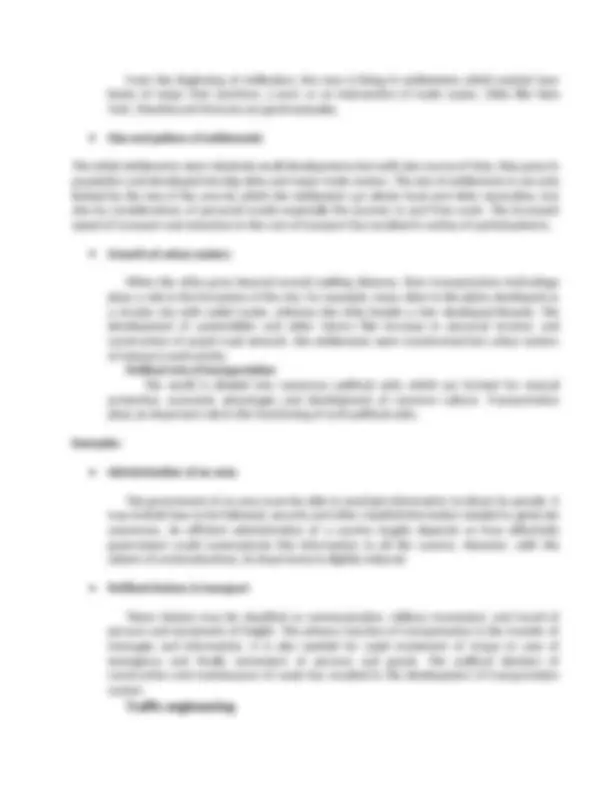
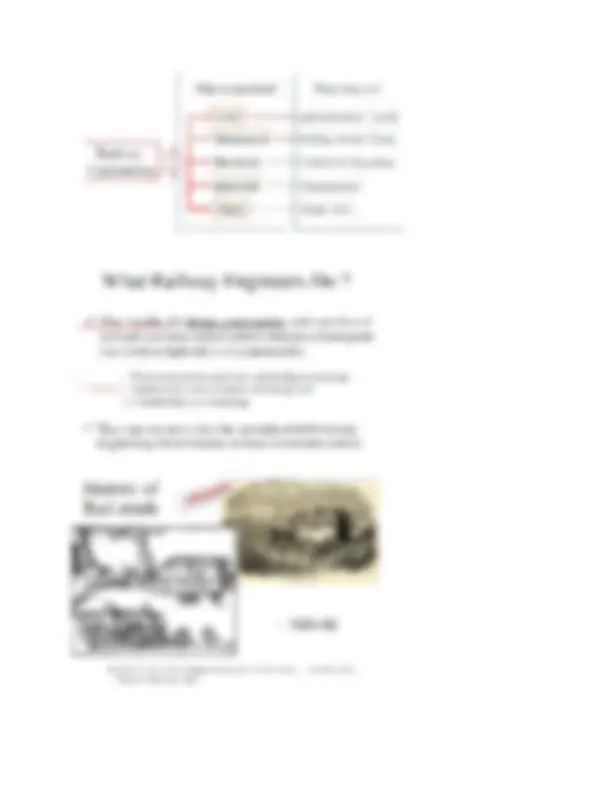
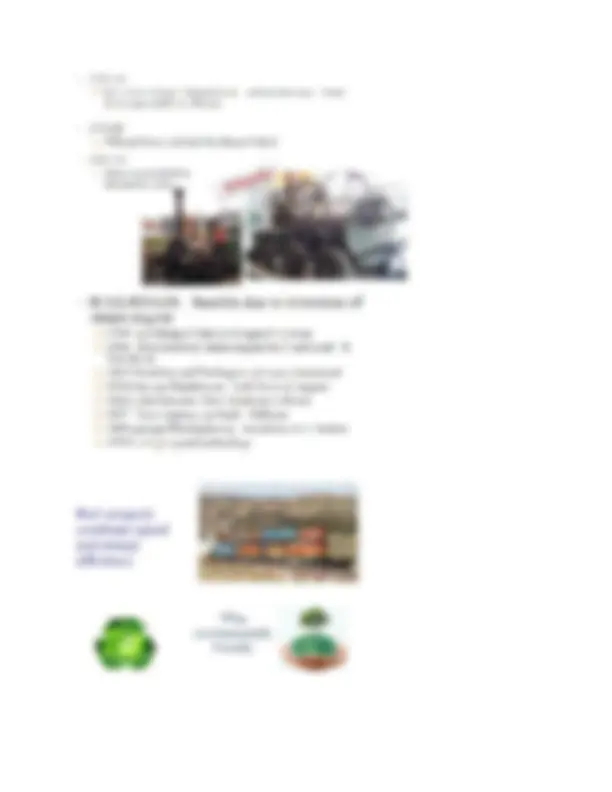
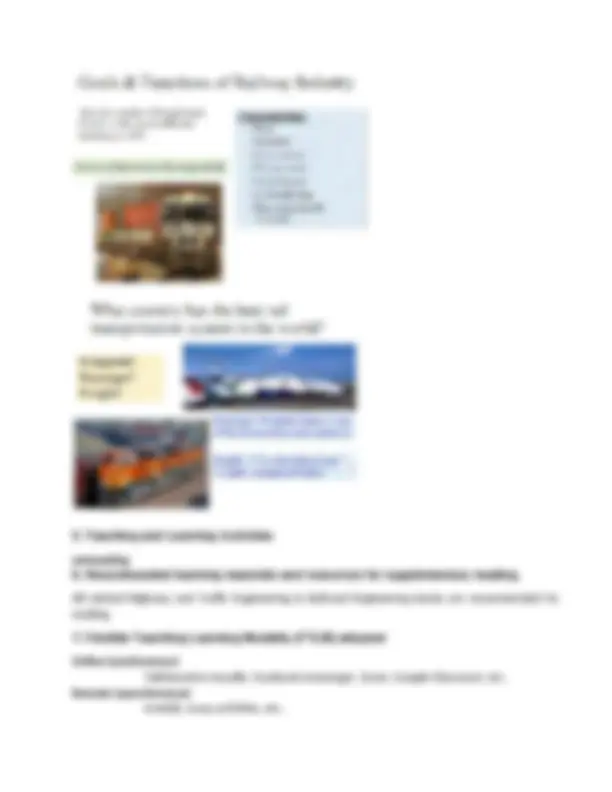


Study with the several resources on Docsity

Earn points by helping other students or get them with a premium plan


Prepare for your exams
Study with the several resources on Docsity

Earn points to download
Earn points by helping other students or get them with a premium plan
Community
Ask the community for help and clear up your study doubts
Discover the best universities in your country according to Docsity users
Free resources
Download our free guides on studying techniques, anxiety management strategies, and thesis advice from Docsity tutors
How transportation change from time to time
Typology: Summaries
1 / 11

This page cannot be seen from the preview
Don't miss anything!







Subject: CE 312 and Highway and Railroad Engineering
1. Title of the Module Chapter 1: Introduction to Highway and Railroad Engineering 2. Introduction We shall start our lesson by defining transportation, highway engineering and railroad engineering. A brief history of the topics will be discussed. This also includes the importance and the different modes of transportation. 3. Learning Outcome Upon successful completion of this module, students should be able to: Outline general background information of transportation and its importance. Describe the role transportation has played in the development of our society Know the different modes of transportation. Learn the history of Highway engineering and Railroad Engineering 4. Learning Content Topic 1 Importance of Transportation Transportation is the movement of people and goods from one location to another. It should be: Safe Fast Economical Comfortable Convenient Environmental sustainable 1.1 Transport of what? Things & People - Early peoples moved from place to place in search of food, carrying their few possessions. - At presently, goods are routinely shipped over long distances to provide the material things expected in modern societies Transportation plays a major role in the development of the human civilization and countries. It can greatly boost the economic development of a country.
Over time, society has put a great expectation on the quality of transport facilities and standards of living. Topic 2 Modes of Transportation Our environment consists of land, air, and water. These media have provided scope for three modes of transport—land transport, air transport and water transport. Two components of land transport: Road transport Rail transport Examples: Highways Car, Bus, Truck, non-motorized ..etc Railways Passenger and Goods Airways Aircraft and Helicopters. Waterways Ships, boats… Continuous Flow systems Pipelines, belts, elevator, ropeway…etc.
Transportation is responsible for the development of civilizations from very old times by meeting travel requirement of people and transport requirement of goods. Such movement has changed the way people live and travel. In developed and developing nations, a large fraction of people travel daily for work, shopping and social reasons. But transport also consumes a lot of resources like time, fuel, materials and land. Economic role of Transportation Economics involves production, distribution and consumption of goods and services. People depend upon the natural resources to satisfy the needs of life but due to non- uniform surface of earth and due to difference in local resources, there is a lot of difference in standard of living in different societies. So there is an immense requirement of transport of resources from one particular society to other. These resources can range from material things to knowledge and skills like movement of doctors and technicians to the places where there is need of them. Examples: The place, time, quality and utility of goods An example is given to evaluate the relationship between place, time and cost of a particular commodity. If a commodity is produced at point A and wanted by people of another community at any point B distant x from A, then the price of the commodity is dependent on the distance between two centers and the system of transportation between two points. With improved system the commodity will be made less costly at B. Changes in location of activities The reduction of cost of transport does not have same effect on all locations. Let at any point B the commodity is to be consumed. This product is supplied by two stations A and K which are at two different distances from B. Let at present the commodity is supplied by A since it is at a lesser distance but after wards due to improvement in road network between B and K, the point K becomes the supply point of product. Social role of transportation Transportation has always played an important role in influencing the formation of urban societies. Although other facilities like availability of food and water played a major role, the contribution of transportation can be seen clearly from the formation, size and pattern, and the development of societies, especially urban centers. Examples: Formation of settlements
From the beginning of civilization, the man is living in settlements which existed near banks of major river junctions, a port, or an intersection of trade routes. Cities like New York, Mumbai and Moscow are good examples. Size and pattern of settlements The initial settlements were relatively small developments but with due course of time, they grew in population and developed into big cities and major trade centers. The size of settlements is not only limited by the size of the area by which the settlement can obtain food and other necessities, but also by considerations of personal travels especially the journey to and from work. The increased speed of transport and reduction in the cost of transport has resulted in variety of spatial patterns. Growth of urban centers When the cities grow beyond normal walking distance, then transportation technology plays a role in the formation of the city. For example, many cities in the plains developed as a circular city with radial routes, whereas the cities beside a river developed linearly. The development of automobiles and other factors like increase in personal income, and construction of paved road network, the settlements were transformed into urban centers of intense travel activity. Political role of transportation The world is divided into numerous political units which are formed for mutual protection, economic advantages and development of common culture. Transportation plays an important role in the functioning of such political units. Examples: Administration of an area The government of an area must be able to send/get information to/about its people. It may include laws to be followed, security and other needful information needed to generate awareness. An efficient administration of a country largely depends on how effectively government could communicate this information to all the country. However, with the advent of communications, its importance is slightly reduced. Political choices in transport These choices may be classified as communication, military movement, and travel of persons and movement of freight. The primary function of transportation is the transfer of messages and information. It is also needed for rapid movement of troops in case of emergency and finally movement of persons and goods. The political decision of construction and maintenance of roads has resulted in the development of transportation system.
D) British roads British engineer John Macadam introduced what can be considered as the first scientific road construction method. Stone size was an important element of Macadam recipe. By empirical observation of many roads, he came to realize that 250 mm layers of well compacted broken angular stone would provide the same strength and stiffness and a better running surface than an expensive pavement founded on large stone blocks E) Modern roads The modern roads by and large follow Macadam’s construction method. Use of bituminous concrete and cement concrete are the most important developments. Various advanced and cost-effective construction technologies are used. Development of new equipment helps in the faster construction of roads. Many easily and locally available materials are tested in the laboratories and then implemented on roads for making economical and durable pavements. Topic 4 Railroad Engineering The “railway” is a terrestrial mass transport system. Trains move on their own (diesel traction) or remotely transmitted power (electrical traction) using steel wheels* on a dedicated steel guideway defined by two parallel rails. The railway transports passengers and freight. Its capability can extend to cover any distance in any environment (urban, suburban, periurban, regional and interurban). Its range for passengers’ transportation is usually suited to approximately 1,500 km, while for freight the distances can be much greater. From a transport system point of view, it is by default considered to comprise three constituents:
**5. Teaching and Learning Activities nxtmeeting
**8. Assessment Task